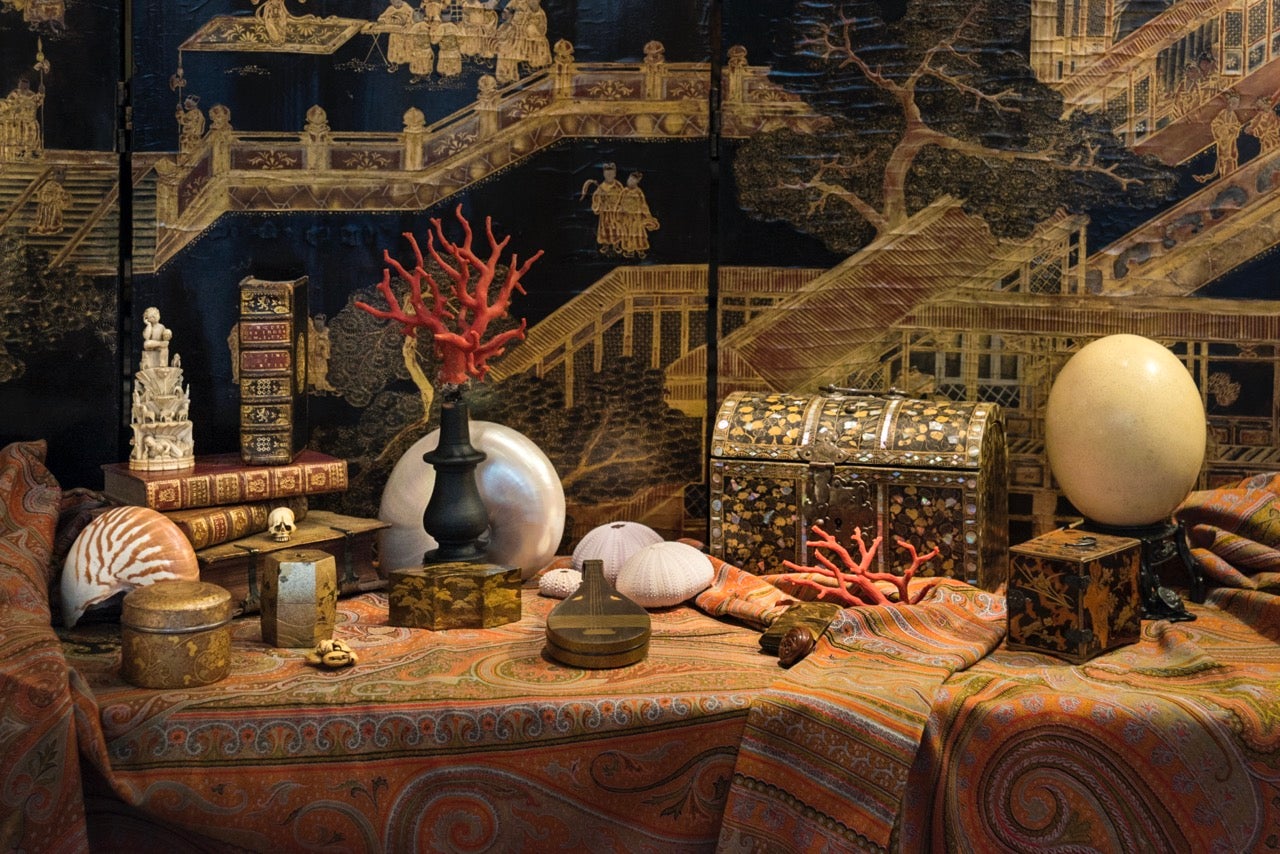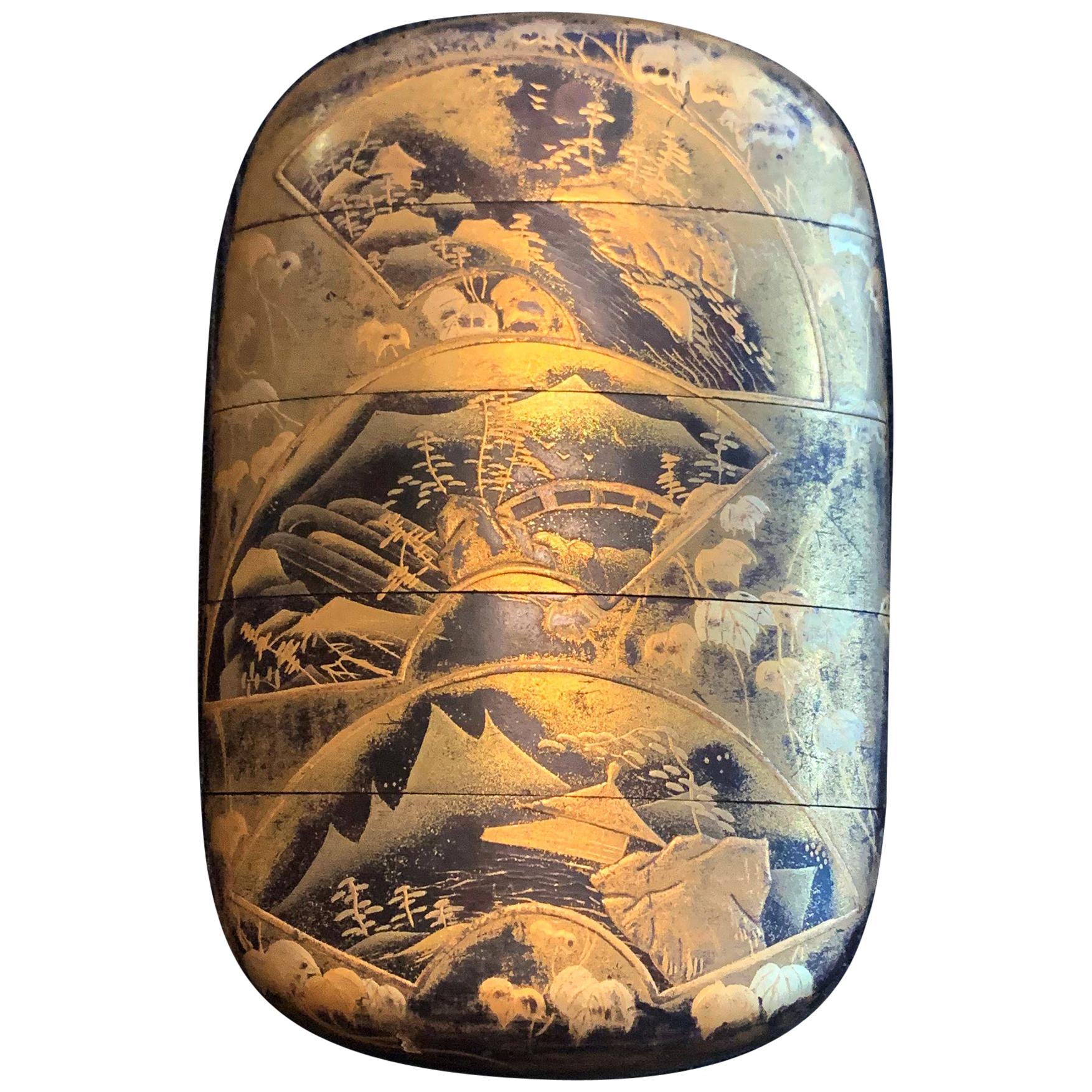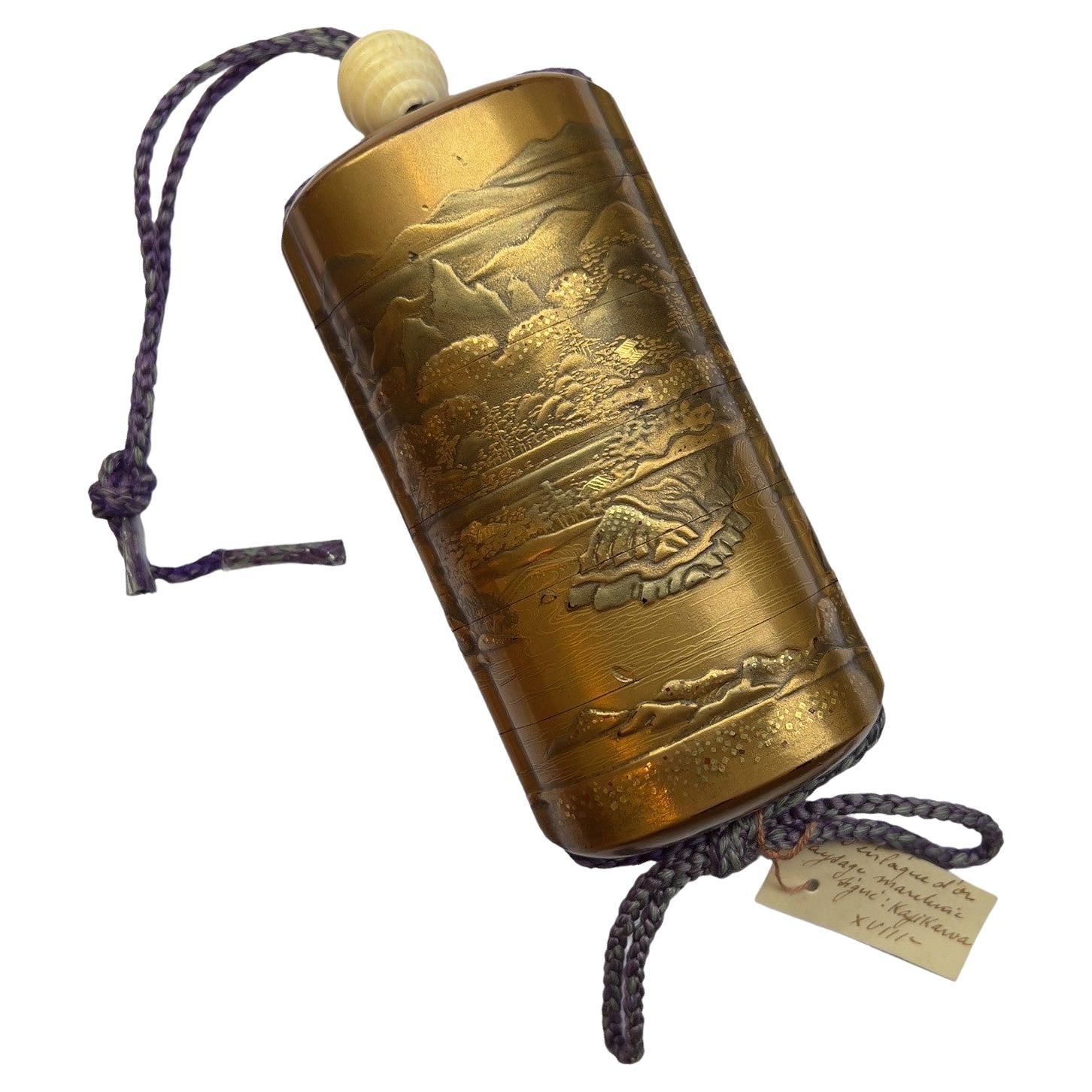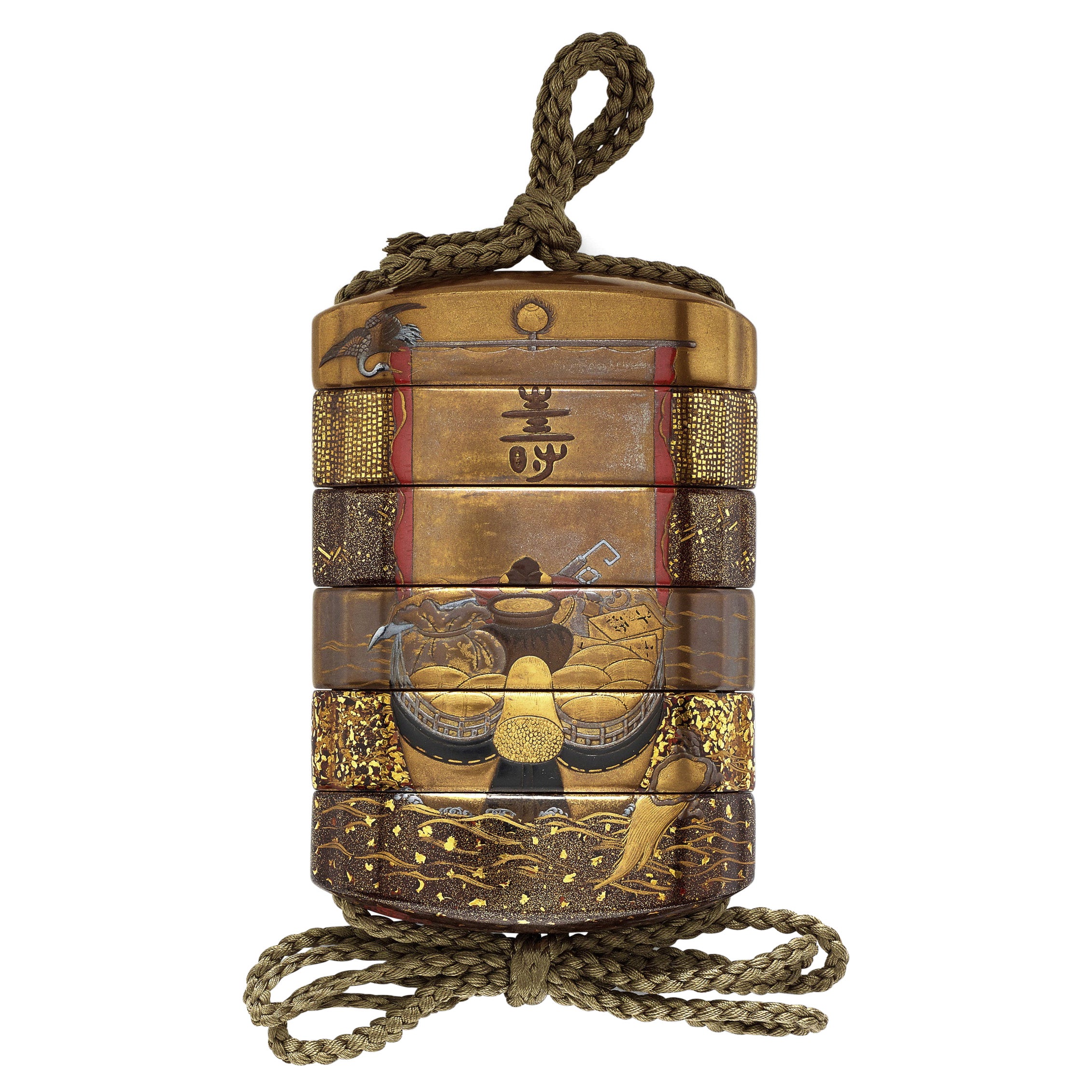Items Similar to Gold Lacquer Inro Decorated with a Lake Landscape
Want more images or videos?
Request additional images or videos from the seller
1 of 8
Gold Lacquer Inro Decorated with a Lake Landscape
About the Item
Inro with four gold lacquer boxes, decorated with a lake landscape. Accompanied by a bronze ryusa manju.
Small boxes formed of compartments that fit one on top of the other, inro (? ?) are traditional Japanese clothing items. Since the kimono had no pockets, everyday objects were carried in small boxes (sagemono) hung on the belt (obi). To prevent them from slipping, a netsuke, a small wooden or ivory figurine, was used to hold the cord of the inro or other types of sagemono. The inro are often decorated with harmonious scenery and scenes inspired by the flora and fauna. Japanese artists play with materials and shapes with precision and thoroughness comparable to goldsmithing.
Representation of lake landscapes bordered by mountains is frequent : Japan is an island country, but also mountainous. Very steep, located in the center of each island, the mountains partition Japanese landscapes. Most regions have their own symbolic and revered mountain, and climbing the mountains is like a pilgrimage. It is thus usual to represent mountains giving way to small plains where the inhabitants dispute the ground with the rice fields and the lakes.
Japan – Edo Period (1603 - 1868)
Height : 2.6 inch (6.6 cm) – Diameter : 1.4 inch (3.6 cm).
- Dimensions:Height: 2.6 in (6.6 cm)Diameter: 1.42 in (3.6 cm)
- Materials and Techniques:Lacquer,Lacquered
- Period:
- Date of Manufacture:1603-1868
- Condition:
- Seller Location:PARIS, FR
- Reference Number:

About the Seller
No Reviews Yet
Vetted Seller
These experienced sellers undergo a comprehensive evaluation by our team of in-house experts.
Established in 2013
1stDibs seller since 2023
- ShippingRetrieving quote...Ships From: PARIS, France
- Return PolicyA return for this item may be initiated within 7 days of delivery.
More From This SellerView All
- Japanese Lacquered Tebako 'Box'Located in PARIS, FRTebako box with three compartments in golden and nashi-ji lacquer, decorated with golden, red, and kirigane lacquer, golden persimmon tree leaves, among rocks. The compartments are of increasing size from the top. The decoration is in continuity. Persimmon has been cultivated in southern China for more than 2500 years and is believed to have been introduced to Japan in the 8th century. The veneer is a tree with very hard wood, similar to ebony. According to a legend, one specimen survived the atomic bombing of Nagasaki on August 9, 1945, close to the epicenter. It is therefore in Japan a symbol of strength and longevity. It is also the national fruit of the country. It is eaten as a traditional dish during New Year's Day celebrations. Tebako literally means "portable box...Category
Antique 1860s Japanese Lacquer
MaterialsLacquer
- Japanese Lacquered Furoshiki Kobako 'Box'Located in PARIS, FRRectangular and flat lacquer Kobako (small box) representing a furoshiki knot seen from above. Fundame background, furoshiki in takamaki-e with floral pattern, inside the folds of the fabric with black and gold sayagata pattern with togidashi maki-e technique. The saya (or sayagata) pattern is composed of Chinese swastikas...Category
Antique Late 19th Century Japanese Lacquer
MaterialsLacquer
- Japanese Lacquered Natsume 'Tea Box'Located in PARIS, FRNatsume in dark red lacquer, decorated with autumn leaves and cherry blossoms in hiramaki-e and nashiji. Interior in black lacquer. Maple leaves (Momiji) are celebrated in literatur...Category
Mid-20th Century Japanese Lacquer
MaterialsLacquer
- Japanese Tiny Suzuribako 'Writing Set'Located in PARIS, FRTiny suzuribako (writing set) in black and gold hiramaki-e lacquer with water plantain (Alisma plantago-acquatica) decoration. Interior in nashi-ji lacquer, with a rectangular water cup...Category
Antique Late 19th Century Japanese Lacquer
MaterialsLacquer
- Japanese Black and Gold Lacquer KushibakoLocated in PARIS, FRKushibako (comb box) in black lacquer with gold lacquer decoration of arrows and my in the shape of three assembled commas " mitsudomoe " (Okabe; Itakura; Kuki; Hijikata; Arima famil...Category
Antique Late 19th Century Japanese Lacquer
MaterialsLacquer
- Black and Gold Lacquer Suzuribako 'Writing Set'Located in PARIS, FRBlack and gold lacquer suzuribako (writing set) in takamaki-e on a nashi-ji background representing two tigers near rocks, bamboos and plum blossoms in a night landscape. Inside of the lid with a lake landscape. The interior of the suzuribako is composed with an inkstone, topped by a copper water bucket in the shape of a chrysanthemum on the left side, with a brush and a small knife. It includes in the right part a storage compartment. Inscription under the inkstone "Inkstone made by Nakamura Chobe". Although the tiger is not native to Japan, it has a high symbolic. The figure of courage was introduced by Buddhism from China. According to the Chinese tradition, the tiger is from one of the stars of the Great...Category
Antique Late 18th Century Japanese Lacquer
MaterialsLacquer
You May Also Like
- Fine Japanese Lacquered Inro with Inlays by KajikawaLocated in Atlanta, GAA Japanese four-case lacquer inro by a member of Kajikawa family circa 19th century (late Edo to early Meiji period). It depicts a nocturnal scenery of a meandering stream surrounded by bush clovers, where a full moon is reflected on the water. It was masterfully decorated in gold and silver maki-e using a combination of techniques including takamakie, togidashi and kirigane as well as aogai (abalone shell) inlays. The stream was set between the slightly elevated banks, adding to this piece a already strong three-dimensional composition. The interior was decorated in gold nashiji. It was signed on the bottom "Kajikawa Zou" (made by Kajikawa and a pot seal centered with "Ei" in Kanji. In one of the compartment, there is a katakana mark, appears to be a name, possibly the owner. Kajikawa clan was one of the most famous lacquer artisanal family established in the 17th century. Many well known members over the generations produced lacquer art in a wide range of formats, but two third were signed only with the family name such as this one. It is therefore not possible to pinpoint the exact author of this piece. Provenance: This inro was purchased as lot 349 in Christie's New York sale Japanese...Category
Antique 19th Century Japanese Japonisme Lacquer
MaterialsWood, Lacquer, Shell
- Fine Japanese Lacquered Inro by YutokusaiLocated in Atlanta, GAA four-case lacquered Japanese inro by Yutokusai (Gyokkei), a lacquer artist active from 1845-1900 (end of Edo to Meiji period). The slightly round inro features a very intricate design with three unfolded fans on the front and two on the back: each reveals a vignette landscape scenery, likely real places in Japan. Using a combination of hiramaki-e and slight takamaki-e, the artist deftly created the pictures with fine details, rendering the inro as a miniature artwork...Category
Antique 19th Century Japanese Japonisme Lacquer
MaterialsWood, Lacquer
- Rare Japanese Sumi-E Lacquer Inro Yamada Jokasai Edo PeriodLocated in Atlanta, GAA three-case lacquered Inro by Yamada Family circa 18th-19th century Edo period. The inro with slight rounded form is of Kano style and vividly depicts a dragon slithering among the ink clouds on a gold background. Sumi-e togidashi (ink togidashi) technique, in combination with Hiramaki-e, were employed to create the dreamy ambience of this piece. The dragon has a painterly appearance inspired by Chinese ink painting that was often seen on the Japanese folding screens. The back of the Inro was sparsely decorated with the shifting patterns of the darkening clouds with an emphasis on the space intentionally left empty. Jokasai was signed to the base. On the front of the inro there is another miniature signature Hakugyoku Hogen, which is one of names used by Kano Michinobu (1730-1790). The dragon is evidently one of his designs (see reference below). Established by a member of Yamada family in the 17th century, the clan was one of the most prominent lacquer artisanal family for the next 200 years until the end of Edo period in the 19th century. Most members signed their work simply with Jokasai making the identification of the individual artists somewhat impossible. The current Inro on offer, compared to many other pieces by Jokasai, has an uncommon Kano style done in Sumi-e togidashi. Another unusual feature of this piece is that the interiors of the inro was decorated with an interesting gold mosaic inlays (kirigane) on a dark lacquer background, giving it a jewel like quality. For another Inro by Jokasai of a similar style using Sumi-e togidashi but depicts a tiger, see Wrangham collection, no.353, which was offered for sale as lot 256 in Bonham's London Auction: The Edward Wrangham Collection of Japanese Art Part I. 9 Nov 2010. For an ink scroll...Category
Antique 18th Century Japanese Japonisme Lacquer
MaterialsWood, Lacquer
- Japan, Late 18th Century Gold Lacquer Inro by Kajikawa, Edo PeriodLocated in PARIS, FRLate 18th century Inro by Kajikawa. Edo period Beautiful inro in gold lacquer representing a continuous landscape on both sides. The interior in Nashiji lacquer. Some small traces...Category
Antique 18th Century Japanese Lacquer
MaterialsLacquer
- Five-Case Inrō 19th Century Signed Kajikawa Saku Japanese Lacquer BoxLocated in Milano, ITSigned: “Kajikawa saku” and with a red pot seal Height: 3 1/8in (7.9cm) Provenance: Michael Tomkinson Collection Leonard Haber Collection Literature: Michael Tomkinson, A Japanese Collection, London: George Allen, 1898, no. 300 Each case with slightly recessed joints and with different grounds, including kinji, nashiji, togidashi maki-e and gyobu-nashiji, on the obverse decorated with a treasure ship laden with the attributes of the Seven Gods...Category
Antique 19th Century Japanese Lacquer
MaterialsWood, Lacquer
- Japanese Lacquered Box Decorated with Birds and Foliage, Signed, Late 19thLocated in Beuzevillette, FRJapanese lacquered box decorated with birds and foliage signed Lacquered inside and outside Late 19th Century Without key Some scratches and losses Ideal for storing jewelry.Category
Antique Late 19th Century Japanese Decorative Boxes
MaterialsWood
Recently Viewed
View AllMore Ways To Browse
Decorating With Used Furniture
Decorating With Antique
Decorating With Antique Furniture
Lacquered Box
Lacquer Box
Ivory Lacquered Furniture
Antique Lacquer Boxes
Antique Lacquer Box
Asian Country Antique Furniture
Asian Midcentury Artist
Center Island
Asian Art Ivory
Small Lacquer Box
Small Lacquered Box
Asian Artists Box
Antique Ivory Boxes
Antique Ivory Box
Asian Rice





